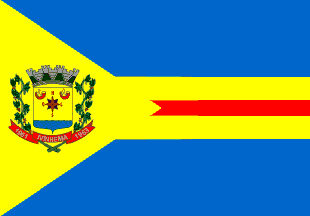 image by Blas Delgado Ortiz
image by Blas Delgado Ortiz
Last modified: 2008-08-23 by ian macdonald
Keywords: mato grosso do sul | ivinhema | triangle | compass rose | horn |
Links: FOTW homepage |
search |
disclaimer and copyright |
write us |
mirrors
At prefeituraivinhema.cjb.net, click símbolos
oficiais for the flag.
Dov Gutterman, 1 July 2001
The official symbols of the Municipality of Ivinhema were created in conformance with
Municipal Law No. 150/73 of 9 August 1973. The flag was designed by the heraldist Prof.
Arcinóe Antônio Peixoto de Faria. It is 14 units wide (hoist) and
20 units long (fly), in accordance with the official dimensions of the national flag of
Brazil, and consists of two blue horizontal stripes,
each five units wide, divided by a yellow stripe four units wide, overlaid in turn
with a red stripe
one unit wide. In the hoist is a yellow isosceles triangle on which the municipal
coat of arms is placed. The law ascribes this design to Portuguese heraldic tradition,
which allegedly holds that municipal flags should be divided into 3, 4, 6, or 8 parts,
with their colors derived from the shield of the coat of arms, and that they should
include a geometric figure on which the coat of arms itself is placed. The law
assigns the following symbolism to the flag:
The coat of arms was also designed by Professor Peixoto de Faria. According to section IV of the municipal law on symbols, it is described in heraldic terms as follows:
Samnitic shield ensigned with a mural crown of six towers argent; the shield or, on the center a compass rose gules and azure, in the cantons, cowboy-style hunting horns gules. In base, water azure wavy argent. As supporters of the shield, to the dexter and sinister, soybean stalks and branches of coffee fructed proper, interlaced at the base, upon which is superimposed a scroll gules containing in silver letters the place-name "IVINHEMA" flanked by the dates "1961" and "1963".The law assigns the following symbolism to the elements of the coat of arms: